Nikon AF-S NIKKOR 500mm f/4E FL ED VR Review
-
Ease
of Use -
Sample
Images -
Lens
Specs -
Rating &
Conclusion -
Main
Rivals -
Review
Roundup - Comment
-
More…

Introduction
The new Nikon AF-S NIKKOR 500mm f/4E FL ED VR lens is set to replace the highly-regarded AF-S NIKKOR 500mm f/4G ED VR in Nikon's professional super-telephoto lens range. The new optic features the same f/4 maximum aperture and FX senor coverage, but Nikon has made several subtle enhancements.
The 'E' designation in the product name denotes an electromagnetic diaphragm which helps maintain consistent exposure during high-speed burst shooting of fast action. ‘FL' signifies that the lens' front element has been given a fluorite coating for easier removal of dirt, dust and smudges.
However, you'll need to save up the $10,299.95 / £8,149.99 / €10,999.00 RRP for a 500mm f/4E to feel its most noticeable difference over the 500mm f/4G: a 790g weight reduction. The f4/E tips the scales at 3090g, which is still not exactly light, but it's a whole D750 body lighter than the old model.
Inside, the 500mm f/4E incorporates three Extra Low Dispersion (ED) glass elements to help reduce flare and chromatic aberration, whilst boosting sharpness and colour accuracy. Vibration Reduction (VR) is employed, enabling a four-stop shutter speed reduction than would otherwise be possible. Nikon has also given the VR system a Sport mode to enable faster, more fluid frame rates when panning with moving subjects.
Ease of Use
Although the 500mm f/4E's headline feature is its 790g weight reduction compared with the 500mm f/4G, this is still a hefty piece of kit which comes in its own CT-505 hard plastic trunk case for safe storage and transportation. Mount the included HK-34 lens hood on the front and a D810 to the back and you'll have a set-up that's approximately two feet in length and 4kg in weight. Consequently, this really isn't a lens designed for handheld use, so you'd be wise to mount it on at least a sturdy monopod to help ensure sharp shots.
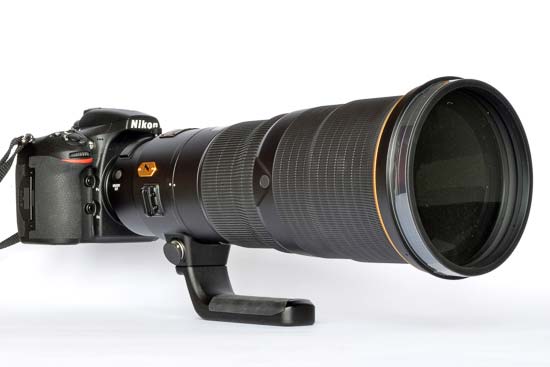 The Nikon 500mm f4E PF ED VR lens attached to a Nikon D810 digital SLR camera
The Nikon 500mm f4E PF ED VR lens attached to a Nikon D810 digital SLR camera
 The Nikon 500mm f4E PF ED VR lens attached to a Nikon D810 digital SLR camera
The Nikon 500mm f4E PF ED VR lens attached to a Nikon D810 digital SLR camera
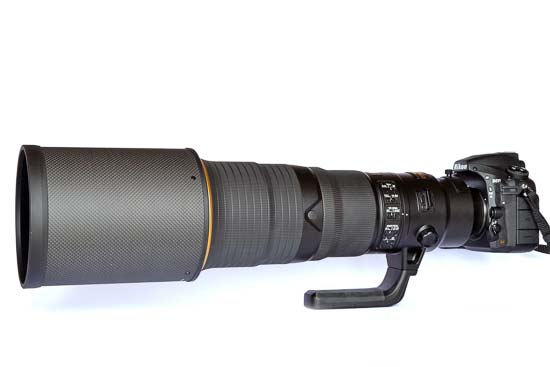 The Nikon 500mm f4E PF ED VR lens attached to a Nikon D810 digital SLR camera
The Nikon 500mm f4E PF ED VR lens attached to a Nikon D810 digital SLR camera
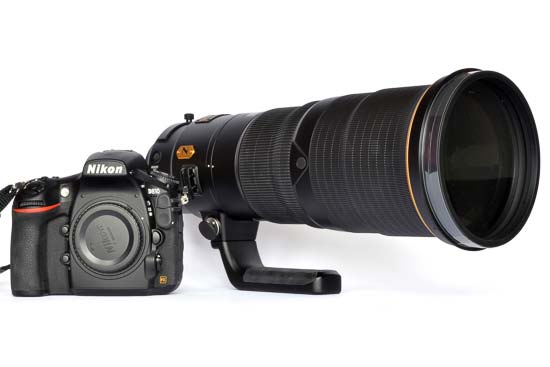 The Nikon 500mm f4E PF ED VR lens alongside a Nikon D810 digital SLR camera
The Nikon 500mm f4E PF ED VR lens alongside a Nikon D810 digital SLR camera
Despite Nikon's weight-saving diet, the 500mm f/4E feels as well made as any other professional super-telephoto optic in Nikon's lens range. The front third of the lens barrel is covered in a fixed rubber grip, and immediately behind this are four buttons located on the right, left, top and bottom of the barrel. These are the Focus Function buttons and can be used to control three possible functions, determined by the Focus Function Selector switch. With the switch set to ‘AF-L', pressing any one of the Focus Function buttons will activate the focus lock when using autofocus. Slide the selector switch to the middle, ‘Memory Recall' position, and the buttons can be used to focus the lens to a pre-stored focus position. Finally, the AF-ON setting on the Focus Function selector switch enables the Focus Function buttons to simply focus the lens if you'd prefer not to use the controls on the camera body.
 Side of the Nikon 500mm f4E PF ED VR lens
Side of the Nikon 500mm f4E PF ED VR lens Side of the Nikon 500mm f4E PF ED VR lens
Side of the Nikon 500mm f4E PF ED VR lens
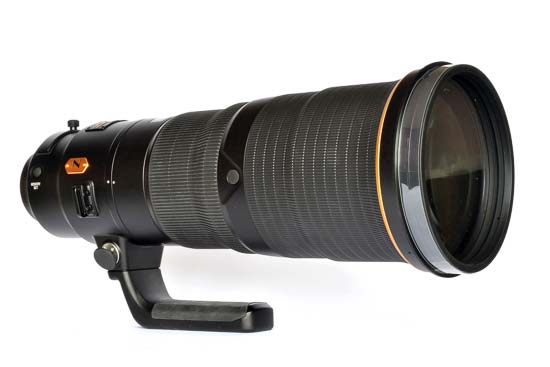 Side of the Nikon 500mm f4E PF ED VR lens
Side of the Nikon 500mm f4E PF ED VR lens
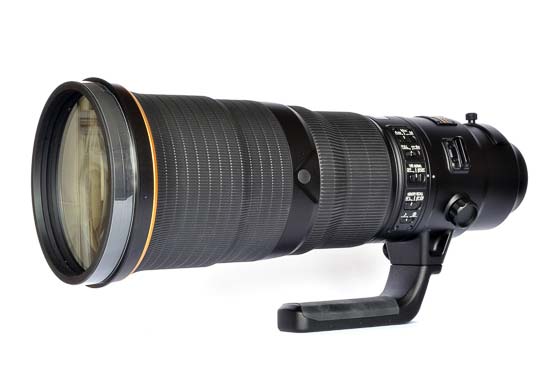 Side of the Nikon 500mm f4E PF ED VR lens
Side of the Nikon 500mm f4E PF ED VR lens
Behind the Focus Function buttons is a large, rubber-coated manual focussing ring, and directly behind this are five selector switches. The topmost changes the focus modes between M/A (autofocus with direct manual override), A/M (the same, but the focus ring needs to be rotated further before manual focussing is activated, in order to prevent accidental focus changes, and the third selector position enables full manual focus. Below this selector is the focus limit switch, giving you the option of the full focus range from infinity down to the 3.6m minimum focus distance, or you can select the infinity to 8m option to help prevent focus hunting when shooting distant subjects.
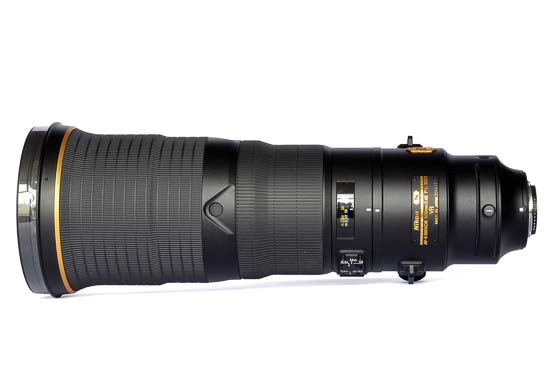 Side of the Nikon 500mm f4E PF ED VR lens
Side of the Nikon 500mm f4E PF ED VR lens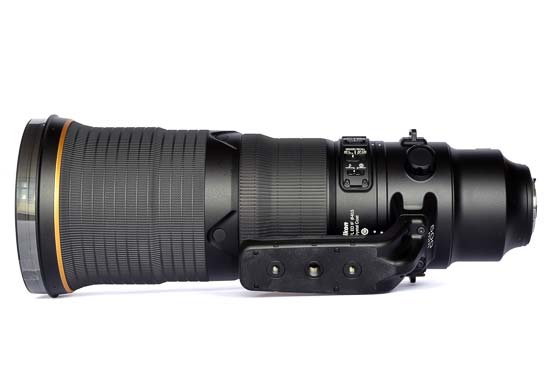 Side of the Nikon 500mm f4E PF ED VR lens
Side of the Nikon 500mm f4E PF ED VR lens
The third of the lens' five sector switches sets the Vibration Reduction. Choose between Off, normal VR and the new Sport mode, whereby the VR system allows the camera to shoot at a faster frame rate to help capture fast-moving subjects.
The bottom two selector switches include the aforementioned Focus Function Selector, and the beep on/off switch. With the latter set to the ‘beep enabled' position, focus on your subject and press the Memory Set button right at the back of the lens, alongside the filter holder, and the lens will store that focus position. It can then be recalled using the Focus Function buttons when the Focus Function Selector is set in the Memory Recall position.
 Front of the Nikon 500mm f4E PF ED VR lens
Front of the Nikon 500mm f4E PF ED VR lens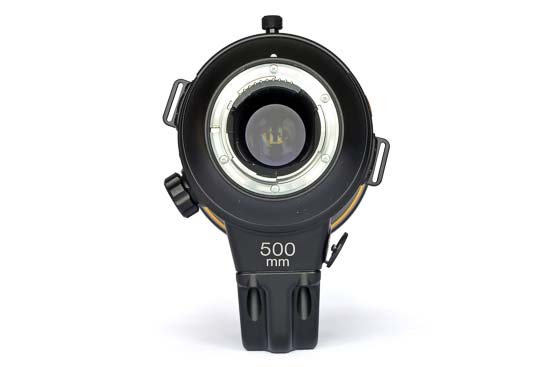 Rear of the Nikon 500mm f4E PF ED VR lens
Rear of the Nikon 500mm f4E PF ED VR lens
Further round from the row of selector switches is a traditional focus distance indicator window displaying focus distance in feet and meters, and behind this is the tripod collar. This boasts new bearings for smoother switching between horizontal and vertical orientation, which can be changed by unscrewing the clamping knob located on the left side of the collar. Either side of the collar are large mounting points for the included LN-2 lens strap. At the base of the collar, just above the tripod mounting foot, is a security slot where you can attach a security cable.
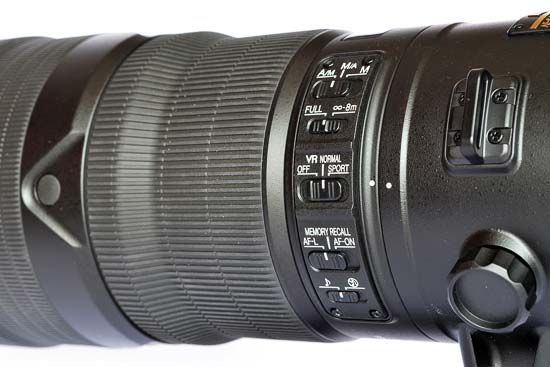 Side of the Nikon 500mm f4E PF ED VR lens
Side of the Nikon 500mm f4E PF ED VR lens
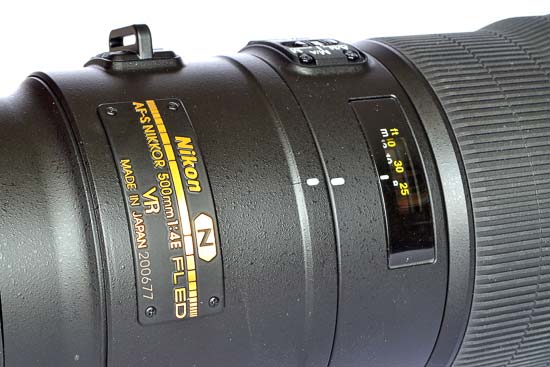 Side of the Nikon 500mm f4E PF ED VR lens
Side of the Nikon 500mm f4E PF ED VR lens
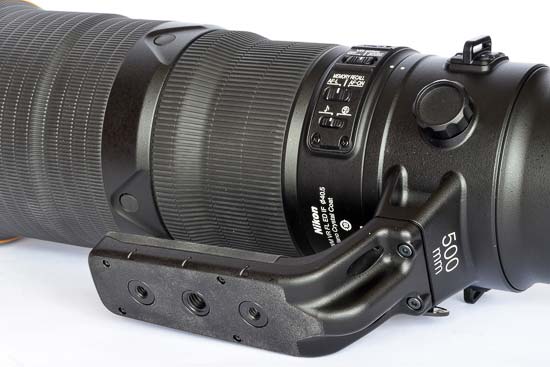 Side of the Nikon 500mm f4E PF ED VR lens
Side of the Nikon 500mm f4E PF ED VR lens
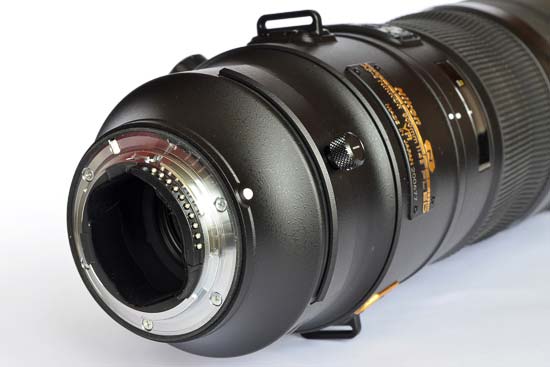 Rear of the Nikon 500mm f4E PF ED VR lens
Rear of the Nikon 500mm f4E PF ED VR lens
At the back of the lens, directly in line with the Memory Set button, is a slip-in filter holder to which you can mount 40.5mm screw-in filters. This is essential, given that the huge 140mm diameter of the front lens element and lack of any screw thread here prevents the use of front-mounted filters.
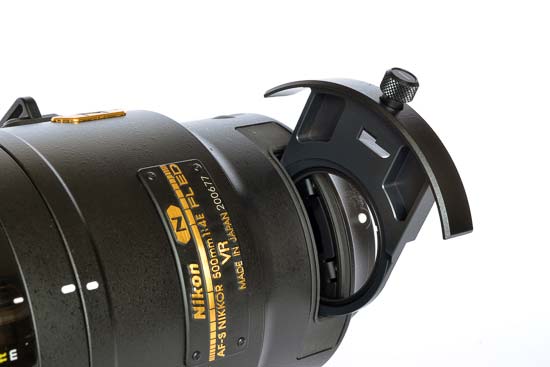 Built-in filter holder
Built-in filter holder
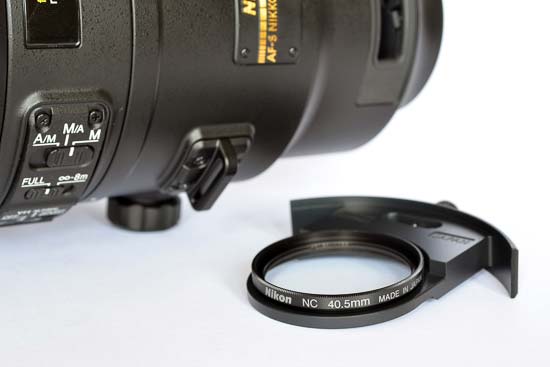 Built-in filter holder
Built-in filter holder
As you'd expect with a professional super-telephoto lens such as this, it can be partnered with a TC-14E-series teleconverter to give a 700mm focal length, whilst a TC-17E-series model provides 1.7x magnification for an 850mm focal length. A TC-20E-series teleconverter can also be fitted for an effective 1000mm focal length.
Focal Range
The lens' 500mm focal length gives an angle of view of 5 degrees on a 35mm full-frame sensor or just 3.1 degrees on a cropped sensor DX Nikon, where the effective focal length becomes equivalent to 750mm.

Focusing
The Nikon 500mm f4E PF ED VR lens has a Silent Wave Motor (SWM) that promises fast and quiet auto focus operation. In use, we have found it to be a reasonably Nikon's Silent Wave Motor AF system functions very quickly and accurately and is barely audible, though you can help avoid possible focus hunting by making use of the focus limit switch depending on the distance of your subject.
Chromatic Aberrations
Chromatic aberration (purple fringing) is almost eliminated by the Nikon 500mm f/4E FL ED VR. We couldn't find any noticeable examples of it, although our test shots didn't include many areas of extremely high contrast.
 |
 |
Light Fall-off
When shooting a pale, uniform surface, light fall-off is apparent at f/4 and there's still some slight fall-off at f/5.6. But at f/8 and narrower, exposures are consistently bright across the whole frame.

Macro
With a minimum focus distance of 3.6m, the 500mm f/4E is definitely not a lens intended for close-up photography. Focus hunting is common when trying to shoot at or near the minimum lock-on distance, so you'd be wise to stay at least four metres from your subject to ensure reliable autofocussing.
 Close-up performance
Close-up performance
Bokeh
With its constant f/4 maximum aperture and long focal length, the 500mm f/4E has no trouble throwing backgrounds completely out of focus. The resulting bokeh blur is very smooth thanks to a nine-blade rounded diaphragm, which provides smoother blurring than seven or five-blade designs. Bokeh is however a fairly subjective part of a lens' image quality, so check out these 100% crops to see the 500mm f/4E's bokeh quality for yourself.
 |
 |
 |
 |
Sharpness
In order to show you how sharp this lens is, we are providing 100% crops on the following page.
-
Ease
of Use -
Sample
Images -
Lens
Specs -
Rating &
Conclusion -
Main
Rivals -
Review
Roundup - Comment
